This was our first meeting, even though we had talked since my quarantine on the phone and had "seen" each other on zoom a couple of times for the dye symposium. But we felt like kindred spirits and though I had barely slept a wink the previous night I was so happy to make this connection in person, finally. This is her very alive indigo vat (the tired one was inside). I've come to notice that the Korean women artists that have the ability to site and build their own studios always have the most lovely views from their workspace. I wish I could say the same of mine back home but that's not the case.
She showed me how she teaches students jogakbo using hanji because it's too much work at first to have them stitch all of their pieces together. The important thing is for them to learn the theory behind it before moving to needle and thread and fabric.
She demonstrated how old bojagi were used, and had straps (and a certain number of straps) based on the type of wrapping cloth, by wrapping her phone in it and "gifting" it to me. She said, if you got this as a gift, you could never throw away the wrapper. You'd use it again. And the proceeded to wrap something else, to show how the bojagi is able to wrap many different shapes of things.
Because we didn't have a lot of time in her studio before we had to drive to the next place, she quickly showed me some of her collection.
This bit is a patchwork for the damaged piece on the other side, to show how important it was for women to mend and repair repeatedly to keep using these cloths.She talked about how one piece is always laid above the next like steps all the way from one side of the cloth to the other, and how tiny pieces like this are always stitched in so that they have friends and don't get lost at the ends to fall away. There is so much meaning and care in these that are very easy to overlook if you don't know what you're looking at.
This one is for a wedding, as you can see the birds.
After she gave me a bunch of crayons to take for a rubbing project I had, she rushed us out to drive in the dark on winding mountain roads. We were on our way to Hongcheon in Gangwon-do, the next province to the east of Gyeonggi-do (where Seoul is), to meet Jang Su-ju at her indigo farm. She had come out with a lantern which looked to me like lightning as she raised and lowered it. We passed it and then I said, I think that was where we were supposed to pull over! We laughed as Mi-sook had already done this before on her last trip to visit the indigo farm.
As predicted, we stayed up late, until 2am talking and having tea and fruit and snacks on a warm floor in a tiny cottage (if you could even call it that), before crawling into sleeping bags. I couldn't sleep because of the unexpected snoring (understandable for a farmer—it's such hard work!) but was glad to be safe and encased in indigo-dyed clothes. When opening the door to the field in the morning, the sight was so calming.That's where we slept! Mi-sook took the loft area that was so small you couldn't sit up. The rest of us were on the floor of the room, off of which was a tiny tiny kitchen and bathroom. It was redone so the interior was all wood.
Su-ju treated us to a huge breakfast spread of samgyetang (boiled chicken soup, stuffed with sweet rice and other very healthy things like ginseng and a Korean date, daechu). The pizza was the first thing she heated and up and it smelled so good but when we sat down to eat all I wanted was everything else, especially the asparagus that grows in the front field, by the next door farmer.
There I am, making a phone call, so glad to get away from everything.
Su-ju runs Kindigo, an indigo studio in Seoul. Of course she can't farm in the city so she grows her indigo plants out here. She also grows natural loofah and in general is also a very experienced natural dyer. But just as Mi-sook concentrates a lot on safflower dye, Su-ju decided to focus on natural indigo (she hates the pre-reduced stuff, all the chemicals. Her indigo is safe enough not to use gloves). Both are not easy but produce glorious color.
She gave me the loveliest gifts, including dyed loofah bits and indigo-dyed underwear! Her work was to cover all of these seedlings with soil as the people helping didn't do that when they first planted. So it's extra work for her but she never complains. She works SO HARD.
I did a little as well and hopefully will remember to buy one of these scooping tools, open on both sides so you dig up soil from the back and then push it to the front to dump.
Because of the cold, these seedlings already started to flower. Su-ju explained that when plants feel like their lives are in danger (in this case, from frost), they do everything they can to spread their DNA before they die. She said this is like babies having babies. When Mi-sook helped with dirt spreading in the morning, I picked flowers off of the seedlings. Su-ju said this explains why pregnancy rates are high during war, because women in fear of their lives (in this case, from rape and pillage and so on) tend to conceive at higher rates than when all's well. I don't know the source of the info but it sounded fascinating. Also, there was proof in the flowers!
The two were diligent in the morning when all I wanted to do was sleep, since I had two consecutive nights without it.
Mi-sook is inside the trellis that Su-ju raised herself to provide support for the loofah planted on the sides. She figured there was so much space inside that she wanted to put down another row of indigo. But her husband got sick that day and couldn't make it out to the farm as planned, so she hoed an entire row herself, laying down vinyl the whole length of the field.
She's showing me her indigo that I believe is fermenting. Eventually this former greenhouse space will be converted to studio and dyeing space so she can hold workshops out here. She told me to nap in the morning, and then we had a snack (pizza! and tiramisu from a visitor who wanted to pick up seedlings), and then we had lunch.
Seafood noodles (haemul kalguksu) at a local place, yum, though I feel like I spoiled my lunch by having so many snacks immediately beforehand.
This is what Su-ju did on her own while I took another nap in the afternoon. Short naps! But extremely necessary. After one more set of visitors who needed seedlings, we got into her vehicle again to head to the bus station so I could ride to Seoul. I finally got to see old family friends that I wasn't able to see earlier on because they had a Covid cases at their church, and they tried to feed me more beef than a family of four would eat. I can't believe how much meat people keep trying to feed me. They also drove me all the way across town to my hotel, and were shocked by how quiet the center of the city was on a Saturday night because of pandemic.
The next two nights I just flopped into bed to recover. I was glad to be able to see a friend from my first Fulbright cohort for a long lunch and tea, commiserating about how hard it is to do this kind of research as a woman and how hard it is to be rejected from the academic community. Then I had lots of family time, including this giant lunch with my aunt and uncle of agujjim (spicy braised monkfish or angler, a chewy fish with lots of meat). Plus a less spicy soup with more of the same agu.
And this delicious rice mixed with minari and seaweed and sesame seeds.
This is minari! And no, I haven't watched the movie yet.Other treats in my family's neighborhood (well, one part of the family, there's lots all over): sweet rice cake filled with red bean paste.
And veggie kimbap from the local place that uses lots of ingredients and not a lot of rice. I love this one because there is so much kkaenip, my favorite green leaves in Korean food (in the perilla family, related to mint).
One entire breakfast when I wanted to stay in all morning at the hotel was more rice cakes of different types, fruit, and tea.
Also had a very good dinner out with two dear old associates from the old days. You can see the kkaenip in non-rolled-up form here.
The rubbing project I wanted to do was at my ancestral grave site, where this particular side of my family goes back 200 years or so.
Two of my aunts were kind enough to take the time to drive me all the way out there and explain some of the gravestones, who was who, before we dug up weeds for a few hours. I was able to see my uncle's, grandparents', great-grandparents', and great-great-grandparents' sites and dig weeds at each one.The project I am involved in is called Jeong, and is a fundraiser in response to the Atlanta murders and generally violence against Asians, Asian Americans, and Asian/Asian-American women. I'm sorry I didn't announce it earlier but I am truly drowning in a mix of research, keeping up with regular life survival, what feels like endless requests from all parts of the world for my time, and being a person not in her home or home country. I hope to make a decent edition but regardless, it's a good cause. I was doing rubbings of the women usually forgotten in Korea. Lately I've been crying more than usual, and once was while here for the first time since my uncle passed away in 2017. I haven't been here since 2008 and my family has created the large stone structure here for more people to be interred (their ashes) together. The inscription is for my uncle and the rest of the spaces will be taken first come, first serve. Now I know where my parents want to go.
In a few hours, I'm going where I have wanted to go for a good long while: Jeju Island.






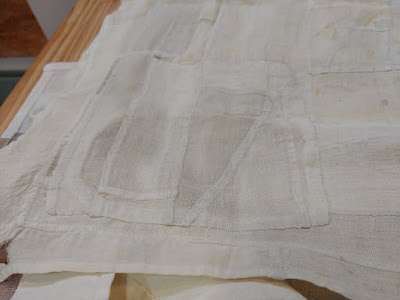

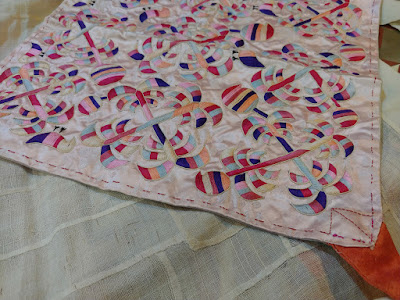













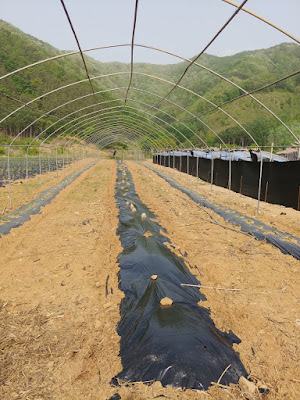
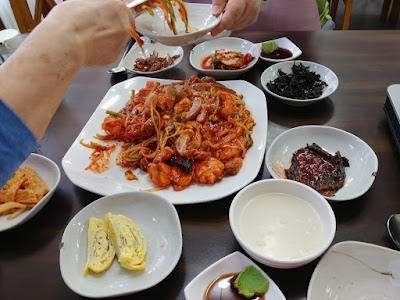







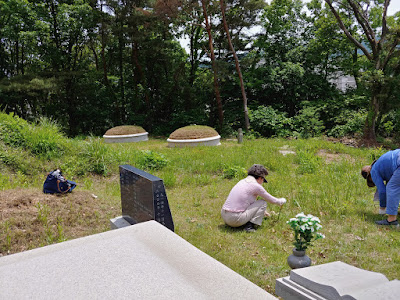
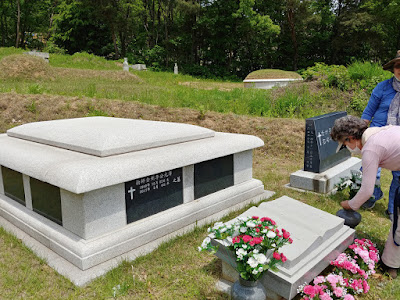
No comments:
Post a Comment